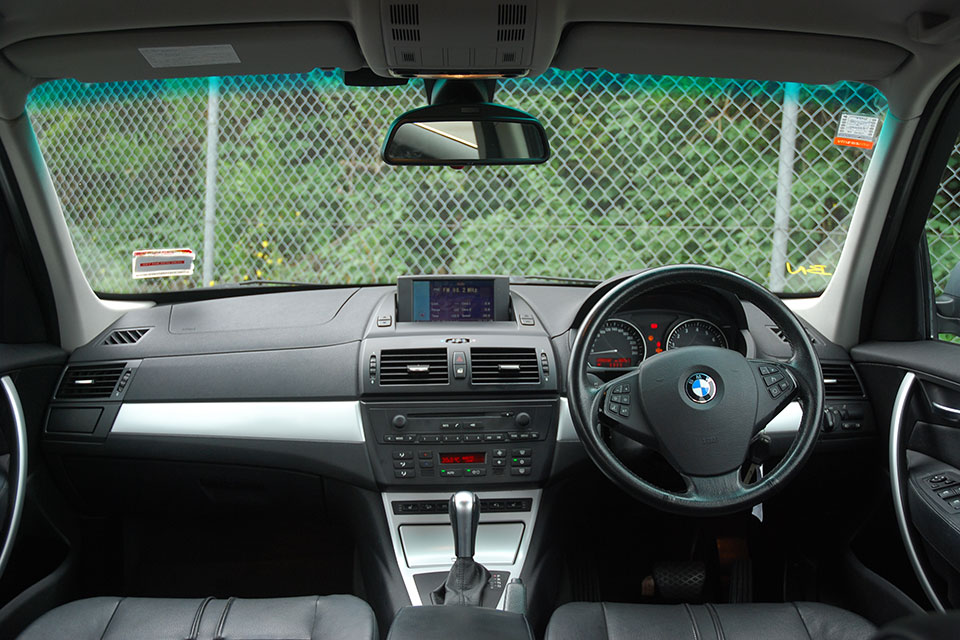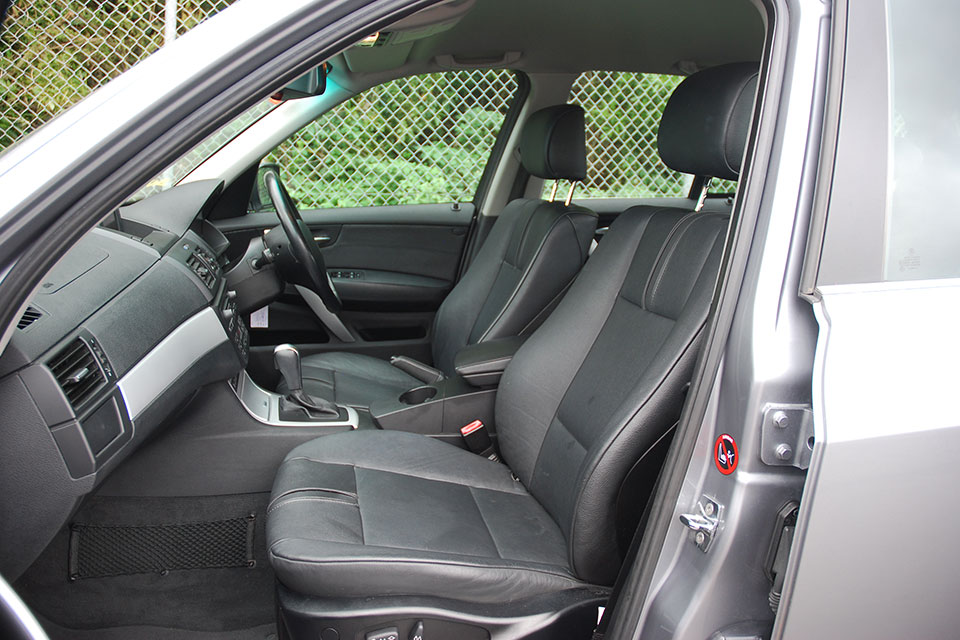BMW X3 2003-2010 used car review
The BMW X3 is a medium SUV with large car interior space.

The BMW X3 is a medium SUV with large car interior space. Its ride will be too firm for some buyers.
Launched as a smaller option to the popular BMW X5, the X3 is based on the 3-Series Touring station wagon. It has a very sporty driving-style for an SUV, which sets it apart from the softer, more comfortable competition. All-wheel drive was standard in New Zealand and Japan.
Inside and out
The X3 features black body cladding around the bottom edge of the car. It offers some protection off the road but is mostly there to make the car look more robust and purposeful. At the front is the BMW family grille, flanked by projector-style headlamps. Alloy wheels are standard, as are roof rails. The rear features a small spoiler and taillights in the rear door that partially match separate units in the back corners.
The dashboard has a sporty look with aluminium trim running across the middle. The gauges are large and trimmed with metal rings. The steering wheel is covered in leather and features stereo and cruise control buttons. Our review vehicle has a pop-up infotainment screen for the stereo, though this is partially in Japanese and will require a band expander to receive local stations.
The heated front seats in our X3 are electrically adjustable with memory functions that allow them to change automatically. The shape of the seats can also be adjusted. They are firm and supportive, yet still comfortable. The seating position is very upright, which some drivers might not enjoy.
The X3's boot space is large and practical, with a square shape and handy rails that allow you to move tie-down points – great if you need to secure sports equipment. At 480 litres, it is bigger than both the 3-Series it is based on and the larger X5. The seats split and fold forward, expanding space to 1560 litres. With this configuration, an optional bike rack fitted to some cars allows you to carry bikes inside the vehicle upright.
On the road
New Zealand-new X3s were available with a choice of 2-litre four-cylinder turbocharged diesel engine, 3-litre six-cylinder turbocharged diesel, 2.5-litre six-cylinder petrol and 3-litre six-cylinder petrol. The latter engines were the only choices in Japanese import cars.
The “xDrive” all-wheel drive is standard, with the choice of a six-speed manual or more common six-speed automatic. Our review car has the 3-litre petrol engine, which produces 200kW and 315Nm. It is a smooth and relaxed engine that gives a satisfying growl when pushed.
The transmission is also smooth and can be shifted manually. The way the X3 drives is sporty, with a firm ride, lots of grip and responsive steering. This firm ride and a very upright seating position might make it a little uncomfortable, particularly for driving hard. The all-wheel drive system gives a small amount of off-road ability, though it is best kept to gravel roads and ski fields.
Thanks to the high sitting position, visibility is good for the driver but the high rear window does create a slight blind spot behind the car. Parking sensors are standard and do an excellent job, though the optional reversing camera is nice to have. Fitting a camera yourself costs from $50 or a professional will do it from $200.
The X3 has a good tow rating for a small SUV. The 3-litre models can pull 720kg unbraked (a medium-sized garden trailer), and up to 2,000kg braked (a medium-sized trailer boat). The four-wheel drive system will be helpful on boat ramps.
Safety
There is no safety rating for imported versions of the X3 although, with the same specifications as the New Zealand-new version, its four-star ANCAP score (2007 and onwards) should apply. That’s a slightly low score for this type of vehicle, with the car given a marginal result for chest and leg injuries in a frontal-offset test. Standard safety specifications are high and include front, side and curtain airbags. Electronic stability control and electronic brakeforce distribution are also standard.
ISOFIX child seat mounts are found in the rear seat window positions. All three rear seats feature full shoulder-style belts, which offer more protection than lap-only belts.
Reliability
The BMW X3 appears to have a higher reputation for reliability than other BMWs of this era. The engine in the 3.0Si uses a timing chain which will not require regular replacement. It is considered reasonably reliable, although there are reports of issues with coil packs and injectors, so keep an ear out for rough running or any hesitation at start-up.
The electric water pump needs to be checked and, if necessary, replaced during services, which can cost more than $1,000.
Mismatched tyres can cause issues for the all-wheel drive system. Check they are all the same type and in the same condition. A new set is likely to cost well over $1,000, so it is best to avoid the need to buy a set soon after you get the car.
Cases are beginning to appear of headliner fabric separating from the ceiling. Replacement costs start from a few hundred dollars but can rise if the area affected interferes with the curtain airbags.
Cost of ownership
BMW recommends servicing the X3 every year. The car has a system that detects if it needs more frequent servicing and will let you know through the information screen between the gauges. A BMW dealer quoted $400 for each service.
RightCar estimates that over 14,000km of driving a year, a 3.0Si will cost $2,880 to fuel. The 67-litre fuel tank will cost $134 to fill at $2 per litre and should take you 600km before the fuel light comes on.
A vehicle licence for the X3 costs $76.92 a year, with the car in the cheapest ACC levy group.
Trade Me Insurance estimates insurance for an X3 valued at $14,880 will cost $57.72* per month.
Buyers’ guide
The X3 is available on Trade Me priced from $9,000 to $25,000. The 3-litre diesel models are worth the most, and low mileage also appeals to buyers.
New Zealand models
- 2.0d - Powered by a 2-litre four-cylinder turbocharged diesel engine. Features climate control air-conditioning, CD player stereo, leather steering wheel, cruise control, parking sensors and alloy wheels.
- 2.5i - As per 2.0d. Powered by a 2.5-litre six-cylinder petrol engine.
- 3.0i - Powered by a 2.5-litre six-cylinder petrol engine. Adds leather seats, electric front seats with heating, six-disc CD stacker and rain-sensing wipers.
- 3.0d - As per 3.0i. Powered by a 3-litre six-cylinder turbocharged diesel engine.
Japanese models
- 2.5i - As per NZ 2.5i.
- 3.0i - As per NZ 3.0i.
With the 2007 models, all “I” models were renamed “Si”. A “Motorsport” package, which adds sporty trim and badging, is common.
Timeline
- 2003 Launched internationally
- 2004 Arrives in New Zealand
- 2007 Model receives a cosmetic update and updates to the diesel engines for better performance and fuel economy
- 2010 Replaced by new model
Details
$11,000 to $25,000 for models which have travelled 70,000 to 120,000km
3-litre six-cylinder, 200kW and 315Nm
Six-speed automatic, all-wheel drive
Four-star ANCAP rating (NZ-new model)
Variable depending on use
Space saver tyre
10.3-litres per 100km (claimed)
Premium
4564mm
1855mm
1675mm
720kg (unbraked), 2000kg (braked)
11m
The review covers the BMW X3 for model years 2003, 2004, 2005, 2006, 2007, 2008, 2009 and 2010.
Review vehicle supplied by Turners Cars.
*Our insurance estimates are based on a 35-year-old male with no accidents in the last two years, garaging the car in Mission Bay, Auckland. The car is not used for business and will cover 10,000km to 20,000km a year. We estimate with no option add-ons and $500 excess. Customise your estimate at Trade Me Insurance.
Image gallery
Also consider





